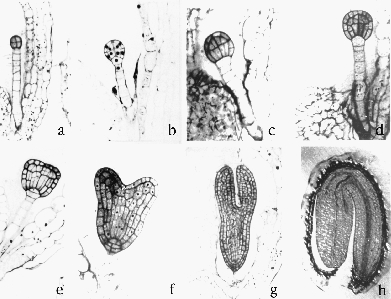
Stages of Arabidopsis embryogenesis. a ; Octant stage; four of eight cells (darkly stained) are visible. b ; Dermatogen stage; a tangential division of each of the eight cells of the “octant” produces inner- and epidermis cells. c, d ; Globular stages; shortly after the dermatogen stage, the cells of the lower tier elongate in the apical basal direction ( c ) endowing the embryo with a morphologically recognizable axis. Cells of the upper tier remain isodiametric and do not display regional distinctions ( d ). e ; Early heart-stage; at this stage a pattern of major elements is recognizable. f ; Late-heart stage; elaborated cell pattern in hypocotyl and root. g ; Mid-torpedo stage; further enlargement of cotyledons and hypocotyl and further elaboration of the radial pattern. h ; Bent cotyledon stage embryo with elaborated radial pattern in different organs.
The Arabidopsis embryo represents a simple, reproducible cellular pattern comprised of few basic tissues and prototypes of leaf- and root-like organs. These structures are generated in a suite of highly reproducible stages that imply tight control of orientation and frequency of cell division as well as cell morphology and differentiation. Embryo-defective mutants and new techniques have enabled functional analyses that eventually provide the perspective of understanding plant embryo development at the molecular level.
There are at least four strong reasons to study Arabidopsis embryos:
First, general developmental processes should be genetically studied at an early stage in the diploid phase of the life cycle, because mutations in fundamental functions often interfere with viability. As an unfolding, highly reproducible cellular pattern in an experimentally amenable genetic background, the Arabidopsis embryo provides unique features for the study basic mechanism by which plant cells are organized in biological patterns. Second, plants and animals have acquired multicellularity independently. Therefore, studying plant development could reveal fundamentally new mechanisms of cellular interaction and signal transduction that have not been identified in animal model species. Third, seed plants are a evolutionary young taxonomic group. This implies that molecular insights obtained in a model species, such as Arabidopsis , can easily be generalized and may lead to applications in a variety of crop plants. Fourth, as we understand the organizing principles generating the body pattern in the embryo, we may also understand and control pattern formation of plant cells in tissue culture. This would dramatically improve our ability to regenerate plants from individual cells in a large number of species.
Further details: T. Berleth (1998): Experimental approaches to Arabidopsis embryogenesis. Plant Physiol. Biochem. 36 (1-2): 69-82.